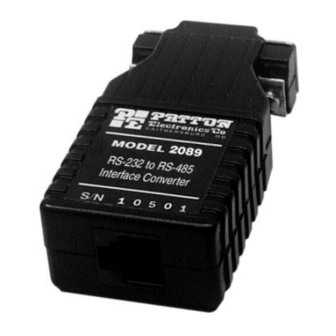Advertisement
Quick Links
Advertisement

Summary of Contents for Patton electronics 2089
- Page 1 USER MANUAL MODEL 2089 Ultra-miniature, DB-9 EIA/TIA-574 to RS-485 Interface Converter SALES OFFICE Part# 07M2089-E Doc# 047043U, (301) 975-1000 Rev. F TECHNICAL SUPPORT Revised 1/22/08 C E R T I F I E D (301) 975-1007 An ISO-9001 http://www.patton.com Certified Company...
- Page 2 However, there is no guarantee that interference will not occur in a particular installation. If the Model 2089 does cause interference to radio or television reception, which can be...
- Page 3 Packages received without an RMA number will not be accepted. Patton Electronics’ technical staff is also available to answer any questions that might arise concerning the installation or use of your Model 2089. Technical Service hours: 8AM to 5PM EST, Monday through Friday.
- Page 4 Distances up to 15.0 miles are attainable at lower data rates (1.2 Kbps, 19 AWG twisted pair). The Model 2089 can handle up to 50 terminal drops in a multipoint polling environment. For RS-485 applications requiring hardware handshaking, the Model 2089 passes one control signal in each direction.
- Page 5 1, below). DIP switch S2 is located on the top of the daughterboard (see Figure 2, below). Switch S1 Figure 1. Underside of Model 2089 main PC board, showing the location of DIP switch S1. Switch S2 Figure 2. Top of Model 2089 daughter board, showing the location of DIP switch S2.
- Page 6 To access the Model 2089’s internal PC boards, insert a small flat- blade screwdriver between the connector and the lip of the case and twist gently as shown in Figure 3 (below). Figure 3. Opening the Model 2089’s plastic case with a small screwdriver Both DIP switch S1 and S2 are marked with individual switch numbers 1 thru 4.
- Page 7 Low (120 Ohm) High (16 kOhm typical) S1-2 and S1-3: 2-wire/4-wire Modes Switches S1-2 and S1-3 are set together to determine whether the Model 2089 is in 2-wire or 4-wire operating mode. Note: 2-wire mode is half-duplex only. S1-2 S1-3...
- Page 8 Controlled by RTS Constantly On S2-2: RTS/CTS Delay The setting for switch S2-2 determines the amount of delay between the time the Model 2089 “sees” RTS and when it sends CTS. Note: RTS/CTS Delay setting should be based upon transmission timing. S2-2...
- Page 9 3.2 TYPICAL APPLICATIONS The Model 2089 is commonly used in five types of applications: 4-wire/full duplex/point-to-point, 4-wire/half duplex/point-to-point, 2-wire/half duplex/point-to-point, 4-wire/multipoint and 2-wire/multipoint. The switch settings generally needed to configure the Model 1008 for these applications are shown in the table below. Note: Do not change switch settings until you have carefully read Section 3.1.
- Page 10 If your application requires you to connect one or two pairs of bare wires to the Model 2089, you will need to open the case to access the terminal blocks. The following instructions will tell you how to open the case, connect the bare wires to the terminal blocks and fasten the strain relief collar in place so the wires won't pull loose.
-
Page 11: Rcv
Note: If there is a shield around the telephone cable, it may be connected to “G” on the terminal block. To avoid ground loops, we recommend connecting the shield at the computer end only. A ground wire is not necessary for proper operation of the Model 2089. (Continued) - Page 12 7. When you finish connecting the wires to the terminal block, the assembly should resemble the diagram below: 8. Place the 2 halves of the strain relief assembly on either side of the telephone wire and press together very lightly. Slide the assembly so that it is about 2 inches from the terminal posts and press together firmly.
-
Page 13: Table Of Contents
This completes the cable installation process. 4.1.2 TWISTED PAIR CONNECTION USING RJ-11 OR RJ-45 The RJ-11 and RJ-45 connectors on the Model 2089’s twisted pair interface are pre-wired for a standard TELCO wiring environment. The signal/pin relationships are shown below:... -
Page 14: Rcv
When connecting two Model 2089s, it is necessary to use a crossover cable. The diagrams below show how a crossover cable should be constructed for the following environments: 4-wire RJ-11, 4-wire RJ-45, 2-wire RJ-11 or 2-wire RJ-45. RJ-11 Cable (4-Wire) SIGNAL PIN# PIN#... -
Page 15: Rcv
HOST FIRST SLAVE SECOND SLAVE XMT+ RCV+ RCV+ XMT- RCV- RCV- RCV+ XMT+ XMT+ RCV- XMT- XMT- Figure 5. Star wiring for Model 2089 host and slaves... -
Page 16: Xmt
The Model 2089 is designed to plug directly into the DB-9 serial port of an EIA/TIA-574 DTE device (PC, laptop, host). If you must use a cable to connect the Model 2089 to the DTE device, make sure that it... - Page 17 6 ft or less. The DB-9 connector on the Model 2089 is wired according to the EIA/TIA-574 Standard, as shown below: EIA/TIA-574 Standard DB-9 SIGNAL 1 -----------------CD 2 -----------------RD...
- Page 18 Carrier: The carrier is switch selected either continuous operation or switched operation, controlled by RTS Surge Protection: 600W power dissipation at 1 mS Power: Draws operating power from EIA/TIA-574 data and control signals; no AC power or batteries required. If necessary, 6-12 VDC can be applied to pin 9 of the EIA/TIA-574 interface.
- Page 20 Dear Valued Customer, Thank you for purchasing Patton Electronics products! We do appreciate your business. I trust that you find this user manual helpful. We manufacture one of the widest selections of data communications products in the world including CSU/DSU's, network termination units, powered and self-powered short range modems, fiber optic modems, interface converters, baluns, electronic data switches, data-line surge protectors, multiplexers, transceivers, hubs, print servers and much more.





